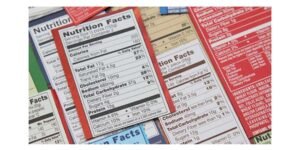
Photo Credit: NIH
The Food and Drug Administration (FDA) has proposed a significant change to nutrition labeling that could soon alter the way consumers evaluate food and drink products. Announced on Tuesday, the proposal mandates that manufacturers display nutrition labels on the front of packaging rather than the back, making key information more accessible at a glance.
Under the new guidelines, labels will also categorize the levels of saturated fat, sodium, and added sugars as “low,” “medium,” or “high,” based on their percent daily value. A “low” rating indicates 5% or less of the recommended daily intake, while “high” signifies 20% or more.
“It is time we make it easier for consumers to glance, grab, and go,” FDA Commissioner Dr. Robert Califf said. “We are fully committed to pulling all the levers available to the FDA to make nutrition information readily accessible as part of our efforts to promote public health.”
The initiative is part of the FDA’s response to the growing prevalence of diet-related chronic illnesses, including heart disease, obesity, cancer, and diabetes.
Nancy Brown, CEO of the American Heart Association, called the proposed front-facing labels “an important step” in addressing the barriers consumers face when identifying healthier food options.
“For decades, the Nutrition Facts label has been an essential tool to educate people about the nutritional content of their food and drinks, but high rates of diet-related illnesses continue to show that additional actions are needed,” she said in a statement.
Last month, the FDA introduced updated criteria for labeling foods as “healthy.” To earn the designation, foods must limit saturated fat, sodium, and added sugar while including components from major dietary groups such as fruits, vegetables, protein, and dairy.
If finalized, manufacturers with $10 million or more in annual food sales will have three years to implement the new labeling system. Smaller businesses will have four years to comply. FDA officials noted during a Tuesday briefing that the updated labels could also encourage manufacturers to reformulate products to meet higher nutritional standards.
The American Beverage Association expressed support for the proposal. “Consumers deserve clear and accurate information on their food and beverages so they can make choices that are right for them,” spokesperson William Dermody Jr. stated.
Credit: USA Today





